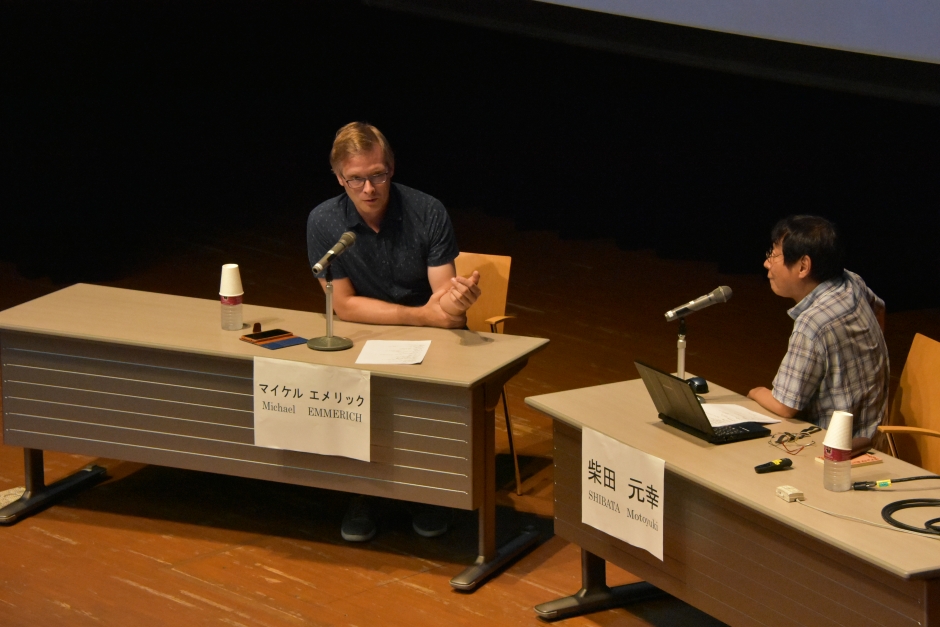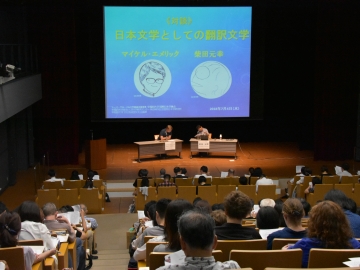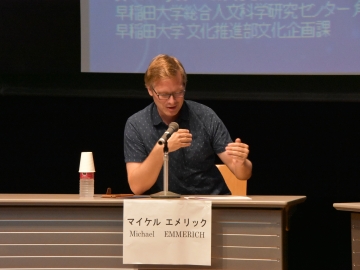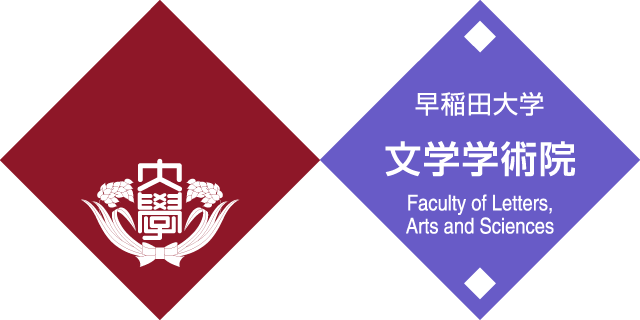- News
- Event report-Reading Translations as Japanese Literature: A dialogue with Motoyuki Shibata and Michael Emmerich
Event report-Reading Translations as Japanese Literature: A dialogue with Motoyuki Shibata and Michael Emmerich

- Posted
- 2018年10月11日(木)
Reading Translations as Japanese Literature: A dialogue with Motoyuki Shibata and Michael Emmerich

On July 4, the Global Japanese Studies Model Unit organized a dialogue between Motoyuki Shibata, translator and professor emeritus at the University of Tokyo, and Michael Emmerich, associate professor at the University of California, Los Angeles (UCLA) and Waseda University, on translations as Japanese literature. This event, which took place at the Ono Auditorium, was co-sponsored by the Research Institute for Letters, Arts, and Sciences, the Ryusaku Tsunoda Center for Japanese Culture, and the Cultural Affairs Division.
The dialogue, moderated by Associate Professor Hitomi Yoshio (Faculty of Letters, Arts and Sciences), started with an opening address by Professor Hirokazu Toeda (Faculty of Letters, Arts, and Sciences).
Shibata and Emmerich started off by looking back at “Translations as Japanese Literature,” a class they co-taught at UCLA in January 2015 which introduced translations from the early Meiji Period and onward. Different matters in regards to translations were pointed out, for example, on how there was a notion that translations should be considered when studying Japanese literature and on what it means to discuss literature.
Next, some translations were read out loud and discussed. In the 1888 and 1896 versions of Ivan Turgenev’s “The Rendezvous” translated by Shimei Futabatei, opinions were expressed on the sophistication in style over the use of kango (Chinese-derived words) in book reviews from that time. Also, when comparing the 1940 and 1965 versions of Lafcadio Hearn’s “Hoichi the Earless” translated by Teiichi Hirai, an observation was made on the fact that readability, or in other words contemporaneity, had higher priority than accuracy from the way punctuations were used. On the other hand, A.A. Milne’s “Winnie the Pooh” translated by Momoko Ishii (2000) has many punctuation marks in the translated text, but contrary to “Hoichi the Earless,” these punctuations create an enthusiastic, rhythmic pattern when reading. Additionally, even expressions which would normally be omitted in Japanese translations, Ishii incorporates them to produce a unique rhythm.

Wide array of topics were discussed during the dialogue, including the following:
■Without studying translated works, it becomes difficult to understand how Japanese literature has evolved. To bear in mind previously translated works is crucial. Otherwise, writings by, for example, Haruki Murakami may seem to have appeared spontaneously.
■Generally speaking, Japanese literature is regarded as works written in Japanese by Japanese authors. However, only a vague sense of what Japaneseness is could be understood this way. On the contrary, from the perspective of recognizing translations as Japanese literature, readers can grasp what Japaneseness is through books circulating in Japan, and a new point of view on Japanese literature differing from conventional methodologies could be established. On the other hand, when reading American literature for instance, it is true that there is a sense of Americanness in it, and being able to feel this way is also important. Simultaneously, there is no need to ignore the feeling of Japaneseness when reading Japanese literature. If readers feel a sense of Japaneseness, they should question themselves reflectively on where that feeling comes from.
■When reading literature, we often construct an image of an author, but in translations, it becomes extremely ambiguous when determining whether the expressions in a text are by the author or the translator. However, in actuality, the same ambiguity also exists in literature written in its original language, but this very difficult to perceive in non-translated works of literature.
As mentioned above, many suggestions were made on how a new point of view could emerge when recognizing translations as an important part of Japanese literature. Together with the audience, this dialogue became a valuable opportunity to discuss how to think about and interpret Japanese literature.
A lively discussion took place during the Q&A session. A variety of questions, for example, on whether Japanese literature, affected by translations, is globally unique; on translations and omissions; on how the influence of translation could be sensed in certain works; and on style and translation from the perspective of early modern literature were asked, expanding the dialogue.
The dialogue ended with a closing address by Professor Kimiko Kono (Faculty of Letters, Arts, and Sciences). As a scholar who studies the classics, she commented on how translating the classics into modern Japanese serves to invite more people to take interest in reading the classics.
Event Overview
Date and time: July 4 (Wed.), 2018, 4:30 pm to 6:00 pm
Location: Ono Auditorium, Waseda University
Sponsored by: Waseda University’s Global Japanese Studies Model Unit, Top Global University Project
Co-sponsored by: Waseda University Research Institute for Letters, Arts and Sciences and the Ryusaku Tsunoda Center of Japanese Culture
Opening remarks: Hiroakzu Toeda (Professor, Waseda University)
Speakers: Motoyuki Shibata (Prof. Emeritus at University of Tokyo) Michael Emmerich (Associate Prof. at UCLA and Waseda University)
Closing remarks: Kimiko Kono (Professor, Waseda University)
Moderator: Hitomi Yoshio (Associate Professor, Waseda University)
Coordinator: Hiroki Matsumoto (Guest Associate Professor, Waseda University Research Council) Kim Young-Long (Guest Lecturer, Waseda University Research Council)
- Tags
- Event Reports
